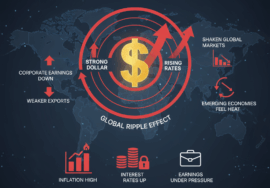India’s Opportunity Amid US-China Trade Tensions

The world is at a critical crossroads, with economic turbulence and geopolitical tensions
shaking global markets. The recent market correction raises questions: Is it the end of a
growth cycle, or a sign of deeper economic and political unrest? As tariffs rise and
national debts soar, we may be entering a new era of economic warfare. Additionally,
Sridhar Vembu, CEO of Zoho, suggests that gold could become key to international trade
as trust in conventional financial systems wanes. The global economy seems poised for
significant transformation.
The Market Correction: A Wake-Up Call
A market correction refers to a 10% drop in stock prices from recent highs. Recently,
increased volatility has been driven by rising inflation, geopolitical instability, and
unpredictable monetary policies. The current correction feels different due to the U.S.
debt crisis, now exceeding $31 trillion, which strains the financial system and pushes up
interest rates. This, combined with tensions between the U.S. and China, has intensified
market uncertainty and investor caution.
The Role of Tariffs: A Form of Economic Warfare?
As global trade tensions rise, tariffs have evolved from trade tools to weapons in
geopolitical rivalry, particularly in the U.S.-China conflict. Tariffs now serve as
instruments of economic warfare, targeting entire economies and exacerbating inflation,
fragmented supply chains, and global instability. This shift towards protectionism
challenges international cooperation, undermining traditional trade agreements and
institutions like the WTO, and fueling further tensions in the global economic system.
Debt: The Looming Crisis
The U.S. debt crisis, with a debt-to-GDP ratio akin to wartime economies, is a major factor in shaping the global economy. Rising global interest rates are intensifying the strain as investors demand higher yields on U.S. Treasury bonds. While many countries face debt challenges, the size of the U.S. debt makes it a focal point. Although unlikely, the risk of default remains, and any disruption to the U.S. financial system could trigger global economic turmoil.
Sridhar Vembu’s Vision: Gold as the New Global Currency?
Sridhar Vembu’s recent tweet suggests that gold could become a medium for international trade as trust in fiat currencies wanes. With rising debt and eroding confidence in central banks, gold may be reintegrated into the global system as a stable alternative. Historically, gold served as a store of value, and countries like China and Russia are increasing their gold reserves. This shift, alongside the rise of cryptocurrencies, signals a move toward alternative financial systems, with gold potentially regaining its role as a hedge against uncertainty.
The Implications: End of Correction or Beginning of War?
The world is shifting towards a multipolar economic order, questioning traditional financial systems and exploring alternative trade methods. The recent market correction may signal a broader realignment of global power. Economic warfare through tariffs and sanctions could evolve into financial battles, with gold potentially replacing fiat currencies. This shift could lead to more bilateral trade backed by tangible assets, reshaping global trade and diplomacy. Whether this marks the end of a correction or the start of a profound change, the global economy is at a critical tipping point.
US tariffs & Tabletop Games can India seize the advantage?
In the event of a US-China war, India could see significant advantages in the tabletop gaming sector, driven by government support and access to raw materials. The Indian government has been increasingly supportive of the “Make in India” initiative, which encourages domestic manufacturing and could lead to a rise in locally produced tabletop games. With disruptions to Chinese supply chains, Indian manufacturers could seize the opportunity to produce game components like miniatures, cards, dice, and boards using locally available raw materials, such as wood, plastic, and metal. This could reduce dependency on China and create a more self-sustaining gaming industry in India.
Additionally, India’s growing tech sector could receive government support for the development of digital versions of tabletop games, further boosting the industry. As the demand for locally made games rises due to international disruptions, India could not only meet domestic demand but also export games to other countries, capitalizing on the global shift away from Chinese manufacturing. This combination of government initiatives and raw material access could provide a strong foundation for India’s tabletop gaming industry to thrive during geopolitical uncertainties.










